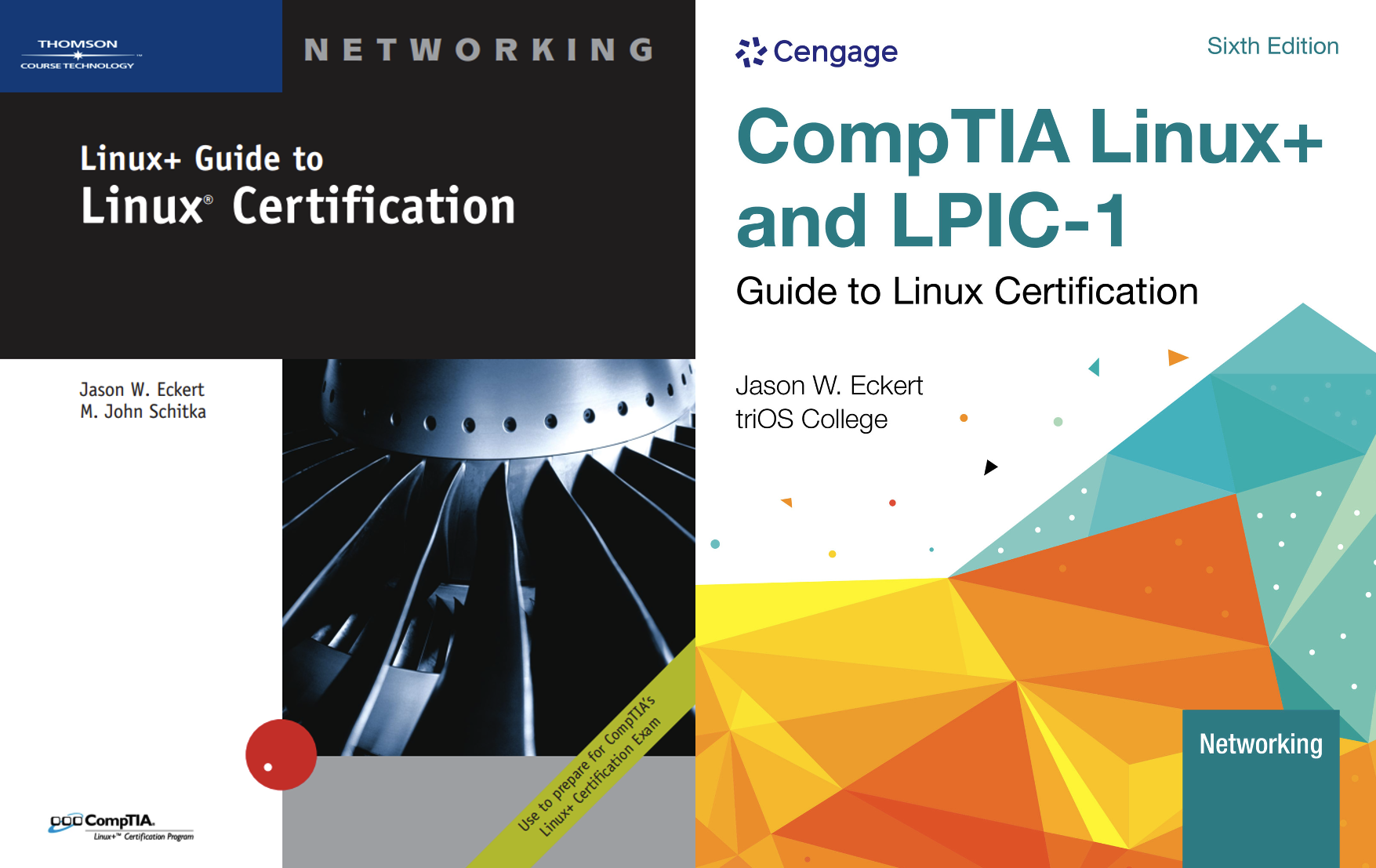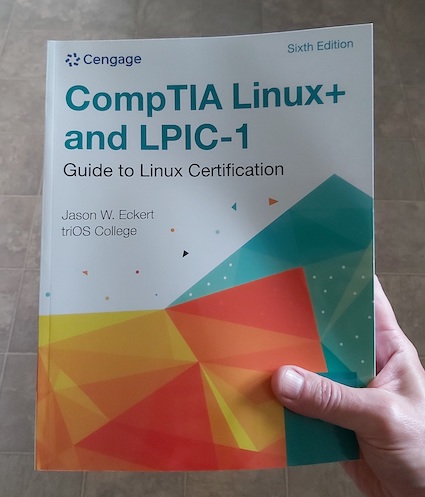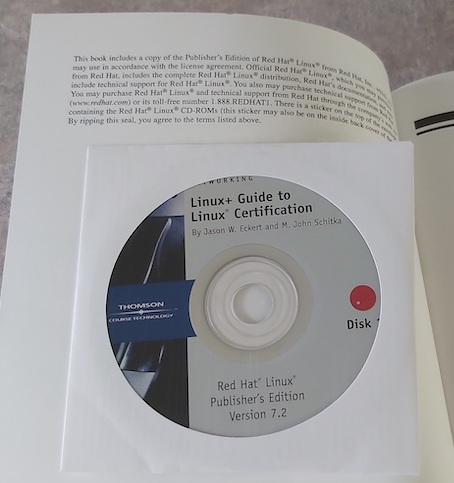My first textbook is now in its sixth edition

While I’ve written many textbooks on different topics over the past two decades, my favourite subject area by far is Linux. After all, Linux has evolved to be one of the most foundational topics in tech education. Information Technology (IT) fields such as server/network administration, cloud administration, cybersecurity, and software development now require a solid grasp of the Linux operating system.

The first textbook I wrote (Linux+ Guide to Linux Certification) was in 2001 for Course Technology (now Cengage). I finished the sixth edition of that title earlier this year, and print copies of it just arrived on my doorstep today!
When I agreed to write that first edition in 2001, the few Linux textbooks on the market all had a poor concept flow and/or content that was difficult for students to absorb. So I set out to create a Linux textbook that I actually wanted to use in my own classroom. It had to have a practical focus, contain a logical progression with zero prerequisite gaps, as well as include step-by-step lab exercises to reinforce everything. The detailed design took me several weeks, and I remember having to go back to the drawing board at least a dozen times. But once that was solidified, the writing of each chapter went smoothly, and the final product became an instant hit with colleges.
This design also stood the test of time. Even though the sixth edition includes many new topics that didn’t exist in 2001 (e.g., Systemd, Git, virtualization, Docker, CI/CD, Kubernetes), most of the book still retains the original topic flow from the first edition.
However, other features have changed from edition to edition. The first edition was greyscale, had a detailed back cover (like trade books), and contained a sleeve with two CD-ROMs of Red Hat 7.2 Linux glued inside the cover that students would install on their classroom PC. Later editions moved to colour glossy pages, a plain back cover that only included the ISBN, and an eBook-friendly page layout to allow for digital distribution.
 Once high-speed Internet access became the norm, CD-ROMs were no longer included. Readers were instead directed to download Linux images from the Internet. And the introduction of mainstream virtualization software later allowed readers to install these Linux images on an existing Windows PC (either in the classroom or at home) to easily explore concepts across multiple Linux distributions.
Once high-speed Internet access became the norm, CD-ROMs were no longer included. Readers were instead directed to download Linux images from the Internet. And the introduction of mainstream virtualization software later allowed readers to install these Linux images on an existing Windows PC (either in the classroom or at home) to easily explore concepts across multiple Linux distributions.
Between 2010 and 2018, CompTIA partnered with the Linux Professional Institute (LPI) to provide the Linux+ certification, which meant that the CompTIA Linux+ and LPIC-1 exams were identical. But when they went their separate ways in 2019, I modified the title to ensure that the book targeted both the new CompTIA Linux+ as well as LPI’s LPIC-1. I also added detailed appendices that allowed readers to apply their Linux knowledge to macOS and FreeBSD UNIX. Both macOS and FreeBSD are common today, and easy to learn after mastering Linux.
I’m always on the lookout for ways to make the student and instructor experience better, and the sixth edition seemed like the right time to make some important changes. After all, the diversification of learning that was accelerated by the COVID pandemic made it clear that the need for flexibility in pedagogy is paramount. There should be no barriers to implementing a technology course in any learning environment, and for any learner.
Consequently, I wanted the sixth edition to be suitable for instructor led courses (in-class and online/remote), as well as self-paced learning environments (self-study, online non-instructor led). Additionally, I wanted lab exercises to work on either a Windows or macOS system regardless of processor architecture (Intel/AMD or ARM) using any virtualization product (including free ones). And finally, since new versions of Linux distributions are released frequently (twice per year), I wanted to ensure that readers could always download the latest version of a particular Linux distribution and have it work with the lab exercises in the textbook.
So that’s exactly what I did with the sixth edition.
When it comes to technology requirements, the sixth edition contains lab exercises that can run on any Windows (Intel/AMD or ARM) or macOS (Intel or Apple Silicon) system using Hyper-V, Virtualbox, VMWare, UTM, or Parallels virtualization software. This was relatively easy since the two Linux distributions I direct readers to install within the lab exercises (Fedora Workstation and Ubuntu Server) are available for both Intel/AMD and ARM, and work well with any modern virtualization product.
However, keeping content continuously updated was a bit trickier. I had to find a way to identify things that could change in future Linux distributions and devise a method to provide updates in a short time. Luckily, Linux commands (including those within lab exercise steps) are already tagged within the templates I use to write each chapter in order to allow the compositor to convert them to code font. For everything else that could change in a newer Linux distribution (e.g., configuration file paths), I added a hidden tag that the compositor ignores. I then wrote a script to turn my tagged content from the textbook into sequential tests that could be run automatically each time a new version of Fedora Workstation or Ubuntu Server is released. I’m notified of any tests that fail (which should be minimal), and can quickly note any necessary changes on a webpage that readers are reminded to check at the beginning of the first lab exercise.
The sixth edition represents over two decades of constant improvement and it’s turned into the ultimate Linux primer that I originally wanted it to be. And since UNIX is commonly used today to refer to any operating system that evolved from the original UNIX operating system (e.g., Linux, macOS, and FreeBSD), I guess you could say the sixth edition is now the ultimate UNIX primer as well.
On a similar note, I’ve always been curious to see if I could replicate the same logical and practical approach I used in my Linux books to Windows Server. But aside from a Windows Server 2003 networking book I wrote in the mid 2000s, nearly all of my books have stuck to Linux. So when another Cengage author retired and I was offered the chance to pick up the reigns for a new edition of a Windows Server book in 2020 (Hands-On Windows Server 2019), I jumped at the opportunity and wrote the entire book from scratch in my Linux book style. It turned out to be a runaway hit, and I get emails every month from professors and students praising it as the best Windows book they’ve ever read.
Below is a picture of me holding my latest and favourite books: the sixth edition of my Linux title, and my Windows Server title written in the same style.
